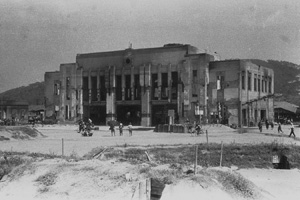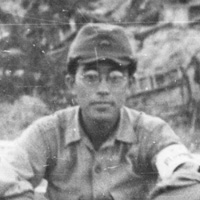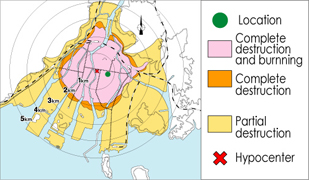 |
Introduction |
 |
|
Asahi Shimbun (newspaper) photographers Hajime Miyatake and Eiichi Matsumoto entered Hiroshima to photograph the devastation soon after the bombing in 1945. Miyatake arrived on August 9, Matsumoto on September 18. Today, 121 of Miyatake's photos and 157 of Matsumoto's remain and all are extremely valuable records of conditions after the bombing. Of the known photos taken soon after the Hiroshima bombing, the Matsumoto and Miyatake photos are exceeded in number only by those taken by Shunkichi Kikuchi and Shigeo Hayashi, who photographed Hiroshima in late September and early October as members of a survey team dispatched by the Special Committee for the Investigation of A-bomb Damages, Scientific Research Council of Japan, Ministry of Education.
The Hiroshima Peace Memorial Museum received these photos in August 2005 from the Asahi Shimbun Osaka Head Office. The majority have never been subjected to systematic analysis or detailed description. Such analysis is ongoing at this museum, but we present a portion of them in this special exhibition. We hope these photographs of victims injured and structures destroyed by the atomic bomb will give you a deeper understanding of the tragic absurdity of war and will help you contemplate what these photographers encountered in Hiroshima and what they sought to communicate.
|
 |
| 1 |
Hajime Miyatake
(1914-1985) |
| Hajime Miyatake, who belonged to the Photo Department of the Osaka Head Office of the Asahi Shimbun, came to Hiroshima as a photographer for the Intelligence Team of the Chubu Regional Military Headquarters. He arrived in Hiroshima the evening of the 9th and took most of his photos on the 10th and 11th. Four days later (probably the 12th), the team returned to Osaka. Of the photos Miyatake snapped less than a week after the atomic bombing, 121 remain.
|
|
 |
| 2 |
Eiichi Matsumoto
(1915-2004) |
| Matsumoto served as staff photographer in the Publications Division, Asahi Shimbun Tokyo Head Office. After the war ended, the newspaper decided to print a special edition on the atomic bombing in its magazine Scientific Asahi. An Asahi reporter and Matsumoto went to Hiroshima and Nagasaki to take photos. They photographed Nagasaki from August 25 to September 15, then headed for Hiroshima. They stayed in Hiroshima from September 18 to 25. Of the photos he took of Hiroshima, the Asahi Shimbun still possesses 157.
|
|
|
| First
Exposé of A-bomb Damage |
 |
| 3 |
| Asahi Graph of August 6, 1952 |
|
When the Allied forces occupied Japan in September, publications and reports were censored under a Press Code. Hajime Miyatake and Eiichi Matsumoto were forced to surrender their prints and were told to burn the film. Over the six-year-plus occupation by the Allied powers, Miyatake hid his film under his porch; Matsumoto concealed his inside his locker at the company. After the Occupation ended, the photos finally came to light in the Asahi
Graph. Photos of the A-bombed cities of Hiroshima and Nagasaki printed in this special edition called First
Exposé of A-bomb Damage profoundly shocked readers around Japan. The edition sold out as soon as it hit the stands. The Asahi Shimbun ran four additional printings with a black and white cover replacing the original color cover. The total circulation reached 700,000, a huge number at the time. |
Notes
 |




